George Washington Drank Here
The first president’s distillery will make whiskey once again
On the banks of the dogue run creek in fairfax County, Virginia, one chilly October morning last year, two men in waistcoats turned their attention away from stirring a pasty sour mash in a hogshead— whose sweet, beery aroma attracted and then drowned multitudes of yellow jackets—to fanning flames out of the glowing embers inside a brick firebox. Anchored to the top of the firebox was a copper pot still, shaped like a dollop of shaving cream. A modern distillery can produce four times as much in a day as George Washington’s could in a year, but the process and technology of pot-still distillation are little changed, and Washington’s venture as a distiller reveals an industrial side of him that is associated with more modern sensibilities.

As a general, George Washington deemed spirits “essential” for the morale and physical well-being of his troops. He himself was a lifelong social drinker, and when he stepped down from the Presidency in 1797, James Anderson, Mount Vernon’s farm manager, persuaded him to build a distillery. Six slaves manipulated the huge amounts of grain (60 percent rye, 35 percent Indian corn, and 5 percent malted barley) and water needed for the mash. The men tended some 50 mash tubs and fed the furnaces that kept the boiler and stills converting the mash to whiskey. The distillery flourished. In 1799 alone Washington’s five pot stills, with a combined capacity of 616 gallons, produced 11,000 gallons of rye whiskey, which generated an impressive profit of $7,500. That output, and the fact that the distillery was the largest known of its kind, offer evidence of Washington’s serious approach. This was no retiree’s hobby. But after he died in 1799, the distillery passed to other owners, and by 1808 it had ceased to operate.
In 1940 federal agents confiscated a dingy copper pot still, bearing a 1787 date, from a house in rural Fairfax County. Because of its age and locale, the pot still was assumed to have been owned by the county’s most famous distiller, and it went to the Smithsonian. It probably did not belong to Washington; holding only 30 gallons, it is much too small. Even so, last year the still was photographed and measured by Rob Sherman, operations manager of Vendome Copper and Brass Works, Inc., in Louisville, Kentucky, which has manufactured distilling equipment for a century. The company crafted an exact replica. On October 21, 13 master blenders and distillers converged at Mount Vernon to use this copy to make a historically accurate version of Washington’s whiskey recipe.
Chris Morris, master distiller at Brown-Forman Corporation, said, “The fact that Washington’s recipe was 60 percent rye makes it a powerful counterpoint to the soft scotch whiskey grain profile. The rye gives the spirit a fruity, spicy character.” Several years from now Mount Vernon Whiskey will be bottled under a special label and delivered to the highest bidders following an auction to benefit Mount Vernon’s educational programs.
All that remains of George Washington’s distillery is a low stone rectangle, incompletely enclosing several rocky trenches and some patches of burned soil. Thanks to support from discus (Distilled Spirits Council of the United States), plans are under way to reconstruct the distillery on its original foundation. The project, expected to cost upward of a million dollars, is slated for completion sometime in 2006.
